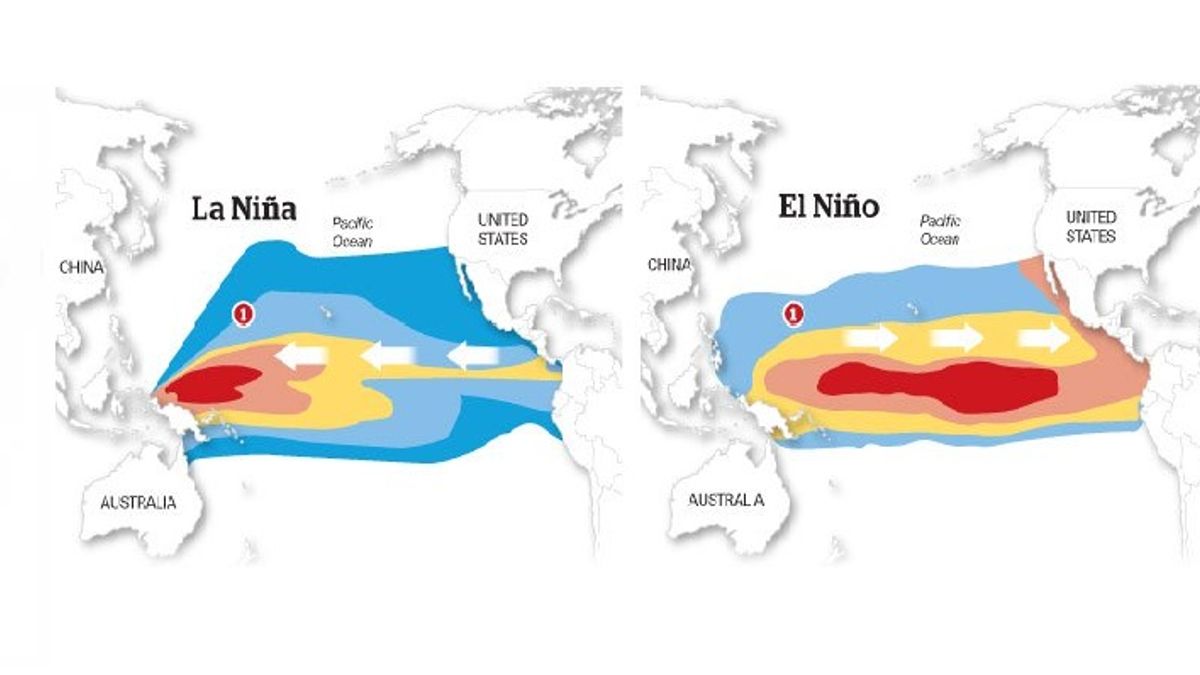El Nino occurs when the easterly trade winds weaken while La Nina occurs when the easterlies strengthen. One of these are that they are caused by changing weather patterns another is that they are associated with temperature change in the water.
Get 1-on-1 help from an expert tutor now.

. Difference between El Nino and La Nina. Typically El Niño and its warm waters are associated with drought while La Niña is linked to increased flooding. Schematic of a La Niña event.
El Nino is warming of the Pacific Ocean between South America and the Data Line. La Niña is essentially the opposite of El Niño. It represents the cold phase of the ENSO cycle.
As a matter of fact El Nino is more widespread than La Nina. ENSO cycle which stands for El Nino-Southern Oscillation cycle is a three phase natural cycle consisting of El Nino which is the warm phase a neutral phase and La Nina which is the cold phase. However it only occurs about half as often as La Nino.
For example they unpredictably create. In Spanish El Niño means The Little Boy or Christ Child and La Niña means The Little Girl. In fact since 1975 La Ninas have been only half as frequent as El Ninos.
It represents the warm phase of the ENSO cycle. For example in 2015 El Niño caused both flooding and droughts in. La Nina La Nina causes sinking motion in the Pacific and rising motion in the Atlantic.
La Nina means the little girl The pattern is the. It is said that El Nino occurs more frequently than La Nina. Answer 1 of 2.
Hope this helped you. La Nina means little girl in Spanish. El Niño and La Niña are the extreme phases of the ENSO cycle.
While an El Niño is an anomalous warming of the central and eastern equatorial Pacific ocean a La Niña is an anomalous cooling of the same area. Another one tells that the motion of the atmosphere affects the water in the ocean which makes it heat up just like how engine heats up when being revved up. El NiÃo refers to the warm episode of the oscillation phenomenon while La NiÃa is the cold episode.
El Niño refers to the above-average sea-surface temperatures that periodically develop across the east-central equatorial Pacific. El Nino and La Nina have many similarities. 2El NiÃo is the more prevalent phenomenon of the two whereas La Nina makes an appearance every few years.
Between these two phases is a third phase called ENSO-neutral. Actually they both originate in the same equatorial locations so in this way they are similar. Derived from the Spanish term which represents little boy.
The change it causes to Sea Surface Temperatures SST will influence our winter weather. El Nino and La Nina Differences between El Nino and La Nina. Then La Niña is the cooling phase.
They may last as long as a couple of years and usually happen every 3-5 years. The eastern and central parts of the tropical Pacific become even colder while the west is warmer and experiences more rainfall. This is the eastern equitorial Pacific Ocean.
1In Spanish El NiÃo stands for child Christ and since this phenomenon would occur around Christmas the name stuck. 7 rows La Nina occurs because of the same winds but when they become more prominent. The cycle is natural and El Niño is the warm phase of the cycle while La Niña is the cold phase.
El Niño conditions occur when abnormally warm waters. One of the important differences between La Nina and El Nino is in connection with the frequency of their occurrence. But because the global weather system is very complex this isnt always the case.
Normally strong trade winds blow from the east along the equator pushing warm water into the western Pacific Ocean. Both phenomena disrupt weather and temperature around the globe. This is where the intensity of the El Nino or La Nina is measured.
El Nino occurs when tropical Pacific ocean trade winds die out and ocean temperatures become usually worm. Trade winds strengthen reinforcing the neutral state described above. While their frequency can be quite irregular El Niño and La Niña events occur on average every two to seven years.
El Niño is the warming phase of the waters in the eastern Pacific off the coast of South America. La Nina on the other stands for little girl and denotes a cold event or a cold episode. El NiÃo means little boy while La NiÃa means little girl.
El Niño and La Niña episodes typically last nine to 12 months but some prolonged events may last for years. They both cause all sorts of unusual weather. This cycle describes abnormally warm and cool ocean temperatures in the eastern tropical Pacific.
La Niña refers to the periodic cooling of sea-surface temperatures across the east-central equatorial Pacific. It accompanies high air surface pressure in the western Pacific. The main monitoring area is known as the Nino 34 OISST Area.
Both patterns tend to happen every 3-7 years and play a big part in how warm or cold US winters will be.

What Is The Difference Between El Nino And La Nina Meteorologist Kelly Reardon Answers Reader Questions Cleveland Com

What Are The Differences Between El Nino And La Nina

What Is The Difference Between El Nino And La Nina Meteorologist Kelly Reardon Answers Reader Questions Cleveland Com

0 Comments